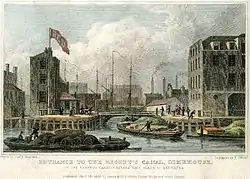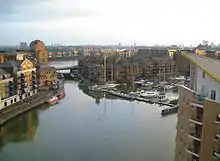Limehouse Basin
The Limehouse Basin in Limehouse, in the London Borough of Tower Hamlets provides a navigable link between the Regent's Canal and the River Thames, through the Limehouse Basin Lock. A basin in the north of Mile End, near Victoria Park connects with the Hertford Union Canal leading to the River Lee Navigation. The dock originally covered an area of about 15 acres (60,703 m2). The Basin lies between the Docklands Light Railway (DLR) line and historic Narrow Street. Directly to the east is a small park, Ropemaker's Fields.
History

The Basin, built by the Regent's Canal Company, was formerly known as Regent's Canal Dock and was used by seagoing vessels and lighters to offload cargoes to canal barges, for onward transport along the Regent's Canal. Although initially a commercial failure following its opening in 1820, by the mid 19th century the dock (and the canal) were an enormous commercial success for the importance in the supply of coal to the numerous gasworks and latterly electricity generating stations along the canal, and for domestic and commercial use. At one point it was the principal entrance from the Thames to the entire national canal network. Its use declined with the growth of the railways, although the revival of canal traffic during World War I and World War II gave it a brief swansong.
The Docklands Light Railway is carried on a viaduct originally built for the London and Blackwall Railway above the original wharves along the north side of the basin. Beyond these, the Commercial Road Lock leads to the Regent's Canal.
To the east of the canal entrance, behind a viaduct arch is the octagonal tower of a hydraulic accumulator, 1869, replacing an earlier and pioneering structure dating from the 1850s by William George Armstrong, engineer and inventor.[1] This regulated the hydraulic pressure of the extensive network of hydraulic mains around the basin supplying the coal-handling machinery. The associated steam raising plant and hydraulic pumps have been removed. The building was converted by Dransfield Owens de Silva for the London Docklands Development Corporation to function as a viewing platform. It (and the basin itself) is now owned by the British Waterways Board; and is a Grade II listed building, and is open every year during Open House Weekend, usually the third weekend in September.
In the 19th century, as steam-power gained dominance, Limehouse's facilities became too small for the new, larger steamships.
The history of the connection of the Basin to the River Thames and the Limehouse Cut is complex. Originally the Basin had three entrance locks to the Thames to separate ship and barge traffic. The smaller upstream entrances were later closed and filled.[2][3] In 1968, a short stretch of new canal was constructed to reconnect the Limehouse Cut to the Basin, replacing the Cut's old direct link with the Thames. It was closed to commercial traffic in 1969, with one quay at the Basin retained for the use of pleasure craft.
Redevelopment

The redevelopment of the Basin started in 1983 as part of the London Docklands Development Corporation's overall masterplan for the Docklands area. However, it took many years for the scheme to come to fruition. The property boom and bust of the 1980s set back progress considerably, as did the construction of the Limehouse Link tunnel which was built under the north side of the basin in the early 1990s. By early 2004 the majority of the once derelict land surrounding the basin had been developed into luxury flats.
Many homes around the Basin were built by Bellway Homes. The developments formed various phases. One of the first phases was Limehouse West consisting of 262 apartments: Medland House (2 buildings - blocks A1/A2 and A3), Berglen Court (3 buildings - blocks B1, B2/B3 and B4/B5) and the Pinnacle (1 building - block B6). Phase 4 consisted of three blocks of apartments and houses on the waterfront at the east end of the basin: Block D, an 11-storey apartment building (Pinnacle II); Block E, nine three-storey townhouses in two terraces of six and three houses; and Block F, a five-storey apartment building.

In addition to the various apartment blocks around the Limehouse Basin, a number of other facilities are available.
The Cruising Association has a purpose-built headquarters at Limehouse Basin, and the John Ding Academy Tai Chi centre (opened March 2005) is located in the retail unit of Berglen Court. Further afield Narrow Street offers many pubs including The Narrow (run by Gordon Ramsay), and The Grapes, a historic pub with an old-style feel.
Just off the basin to the south is the Mosaic development. This has several retail units including La Figa, an Italian restaurant, Verde an Italian delicatessen and cafe, and a dry cleaners.
References
- "Greater London Industrial Archaeology Society".
- Stepney & Limehouse 1870, London Sheet 64 of Old Ordnance Survey Maps, The Godfrey Edition, Alan Godfrey, ISBN 1-84151-255-9
- Stepney & Limehouse 1914, London Sheet 64 of Old Ordnance Survey Maps, The Godfrey Edition, Alan Godfrey, Revised 1999, ISBN 0-85054-069-0
External links
| Wikimedia Commons has media related to Limehouse Basin. |
- Regent's Canal Dock (1812–1970s) from PortCities
- Limehouse West Limehouse West
- Regent's Canal Dock: An introduction to its industrial archaeology from GLIAS website